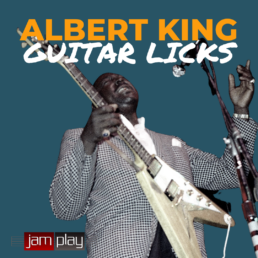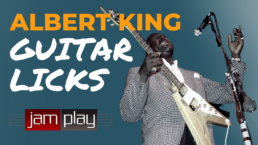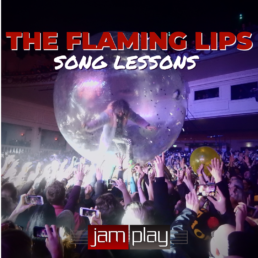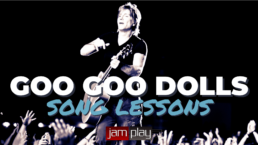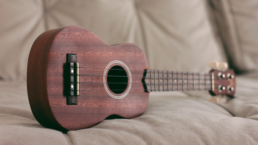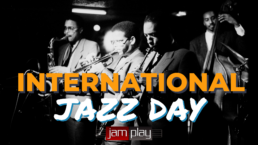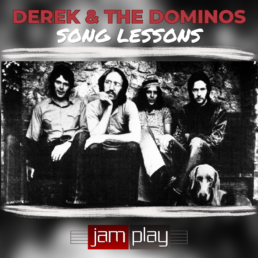Play Guitar Like Albert King
Albert King‘s guitar-playing style was a force to be reckoned with. He was one of the Three Kings of Blues, after all. King’s playing was characterized by his impeccable phrasing, searing bends, and expressive vibrato. His unique approach incorporated a combination of fluid single-note runs and powerful string bends, creating a signature sound that impacted generations of guitarists. Albert King’s influence can be heard in the playing of icons such as Stevie Ray Vaughan and Jimi Hendrix, both of whom acknowledged King as a significant inspiration. King’s mastery of the instrument, combined with his ability to infuse each note with raw emotion, revolutionized blues guitar playing. Even today, his legacy continues to shape the way guitarists approach the instrument.
In other words, if you are learning blues guitar, why wouldn’t you want to pick up a few tips from one of the all-time greats? Luckily, JamPlay’s top educators have distilled the techniques of legendary guitarists like Albert King into interactive lessons that will take your playing to the next level. Keep reading to check out some free Albert King guitar lessons!
Albert King Guitar Lick #1:
In this lesson, DJ Phillips shows you how to play a lick you may have heard before! This impassioned blues lick was a favorite of Albert King’s, who would play it on his infamous Flying V guitar. Get ready to practice some intense string bends and fierce vibrato.
Guitar Lick #2:
Moving on to our second Albert King guitar lick, this one is incredibly versatile. In fact, you can hear Albert King using this in all kinds of situations in his playing. Get ready to practice some pull-offs and faster phrasing. To end the lick, you can use some of the vigorous vibrato you practiced in the last lesson to really give it that Albert King feel.
For more DJ Phillips guitar lessons and an ever-growing library of Song Lessons, check out JamPlay.com! JamPlay has over 450 guitar courses from 120+ instructors, and online guitar lessons tailored to every skill level, music genre, and playing style. Click here to learn more.
Share this
Become a JamPlay member for unlimited access to 7000+ guitar lessons and 120+ artists and instructors. View membership plans ›
Related Posts
June 13, 2023
The Flaming Lips Song Lesson Playlist
The Flaming Lips, an American rock band hailing from Oklahoma City, has had an undeniable impact on the music industry and pop culture. With their innovative sound, unconventional approach to live performances, and distinct visual aesthetic, they have become one of the most influential and beloved rock bands of the past few decades. Formed in 1983, The Flaming Lips started as a psychedelic punk band. The band eventually evolved their sound into a unique blend of alternative rock, neo-psychedelia, and experimental pop. Over their 40-year tenure, they have rightfully been nominated for a number of prestigious music industry accolades. Namely, the band has been for six GRAMMY Awards, three of which they won.
If you’ve made it this far, you’re probably ready to learn some Flaming Lips songs on guitar. Let’s jump right in and learn some tunes!
“Do You Realize??” – The Flaming Lips Song Lesson – JamPlay
From their 2002 album, Yoshimi Battles the Pink Robots, “Do You Realize??” is widely considered one of The Flaming Lips’ most popular tracks. In their 100 Best Songs of the 2000s, Rolling Stone Magazine ranked this song No. 31.
In this lesson, D.J. Phillips shows you how to play the whole song on guitar in its entirety. Follow along the full lesson with tab on JamPlay!
“She Don’t Use Jelly” – The Flaming Lips Song Lesson – JamPlay
“She Don’t Use Jelly” is a single from The Flaming Lips’ 1993 album, Transmissions from the Satellite Heart. The song rose to fame after the show, Beavis and Butt-head included it in their soundtrack. It also peaked at No. 55 on Billboard’s Hot 100 the same year the band released their album.
In this lesson, guitar educator, Matt Brown shows you how to play this rock hit on guitar. Follow along with Matt in the full lesson with tab & jam tracks on JamPlay!
For more Song Lessons, check out JamPlay.com! JamPlay has over 450 guitar courses from 120+ instructors, and online guitar lessons tailored to every skill level, music genre, and playing style. Click here to learn more.
Share this
Become a JamPlay member for unlimited access to 7000+ guitar lessons and 120+ artists and instructors. View membership plans ›
Related Posts
June 9, 2023
Dream Theater Song Lesson Playlist
Dream Theater, the progressive metal band that has captivated audiences worldwide since 1985, stands as an unparalleled force in the world of music. With their complex compositions, technical virtuosity, and thought-provoking lyrics, Dream Theater has left an indelible mark on the genre and continues to push the boundaries of what is possible in music. Furthermore, the band is the proud project of globally-praised guitarist, John Petrucci. Over their three-decade-long tenure, the Dream Theater has been nominated for 3 GRAMMY Awards, one of which they won for Best Metal Performance. Nearly all of their studio and live albums have also ended up in Billboard’s Hot 200 charts.
In this blog, we’re going to cover the Dream Theater guitar lessons we offer at JamPlay! Grab your guitar and let’s get rockin’!
“Endless Sacrifice” – Dream Theater Song Lesson – JamPlay
If you somehow don’t know what “progressive” rock music sounds like, now you do. “Endless Sacrifice” from Dream Theater’s 2003 album, Train of Thought is an 11-minute-long rollercoaster of a track. Undoubtedly the brain child of John Petrucci, you’ll be anything but bored learning this song on guitar.
Follow along with Allen Van Wert as he shows you how to play the song in its entirety. Find the full lesson with tab on JamPlay!
“Pull Me Under” – Song Lesson – JamPlay
“Pull Me Under” was released in 1992 as the first single from Dream Theater’s album, Images and Words. This is arguably the band’s most well-known track, and even peaked at No. 10 on Billboard’s Hot Mainstream Rock Tracks. The album version currently has almost 58 million streams on Spotify alone.
You can learn all the guitar parts to “Pull Me Under” with this lesson from Allen Van Wert. Get the breakdown of all of the parts with the full lesson on JamPlay.
“The Silent Man” – Dream Theater Song Lesson – JamPlay
This one might seem like a curveball – you know, since we introduced Dream Theater as a progressive metal band. “The Silent Man” is a somber, all-acoustic ballad. It features light singing with vocal harmonies, minimal percussion, and simple strumming.
Follow along with Nick Greathouse as he shows you how to play all of the guitar parts for “The Silent Man.” Get the full lesson with tab on JamPlay!
For more Song Lessons, check out JamPlay.com! JamPlay has over 450 guitar courses from 120+ instructors, and online guitar lessons tailored to every skill level, music genre, and playing style. Click here to learn more.
Share this
Become a JamPlay member for unlimited access to 7000+ guitar lessons and 120+ artists and instructors. View membership plans ›
Related Posts
June 2, 2023
AI in Music - Will It Replace Guitarists?
AI in Music - Will It Replace Guitarists?

In recent years (especially in 2023), the intersection of artificial intelligence (AI) and music has captured the attention of both musicians and technology enthusiasts. With advancements in machine learning algorithms and sophisticated music generation models, AI has become capable of composing music, mimicking various instruments, and even generating lyrics. As the potential of AI in music continues to unfold, a lingering question arises: Will AI replace guitarists and other traditional musicians? In this blog, we’ll delve into the world of AI as it applies to music, and explore the possibilities and limitations of this emerging technology.
 The Rise of AI in Music
The Rise of AI in Music
AI has made remarkable strides in the field of music. From composing melodies and harmonies to generating complex arrangements, AI algorithms have the ability to create original pieces that rival the work of human composers. With the advent of AI-powered virtual instruments, musicians can now simulate the sound of a guitar, among other instruments, without requiring a physical presence. AI-generated music has also gained recognition in various genres, including classical, pop, and electronic music.
AI as a Collaborative Tool
Did you watch the video above? Pretty cool, right? Rather than replacing guitarists, AI has the potential to be a powerful collaborative tool. Musicians can leverage AI algorithms to experiment with new ideas, generate fresh musical elements, and explore unconventional compositions. AI-powered tools can act as creative companions, helping artists overcome writer’s block and offering unique suggestions to enhance their musical creations. By augmenting the creative process, AI opens up new avenues for artistic expression.
 Innovative Applications of AI in Music
Innovative Applications of AI in Music
AI in the music world extends beyond composition and performance. It has found applications in music recommendation systems, where algorithms analyze user preferences to curate personalized playlists. AI-powered transcription tools can analyze audio recordings and convert them into sheet music, aiding musicians in the process of learning and sharing music. Furthermore, AI algorithms can be used for audio restoration, noise reduction, and mastering, enhancing the overall quality of recordings.
Expressive Limitations of AI
While AI can create impressive compositions, it still faces certain expressive limitations when compared to human musicians. As you may have seen in the video above, ChatGPT has a hard time conveying technical information into expressive music. Music is an art form that encompasses emotion, nuance, and improvisation. These are elements that are deeply rooted in human experiences. Guitarists, for instance, bring a distinct style and personal touch to their performances. Notably, they are known for infusing their music with passion and feeling. AI, at its current stage, struggles to replicate these subtleties, often resulting in compositions that lack the organic and emotional depth of human-made music.
 Embracing the Future
Embracing the Future
As AI continues to evolve, musicians should view it as a tool that can augment their creativity rather than a threat to their artistry. Collaborations between musicians and AI have the potential to push the boundaries of music composition and performance. By embracing this technology, guitarists can explore new genres, experiment with innovative sounds, and broaden their musical horizons. The synergy between human musicians and AI presents exciting opportunities for the future of music.
Conclusion
AI has witnessed remarkable advancements, yet it is unlikely that it will entirely replace guitarists or other traditional musicians. While AI algorithms can compose music, simulate instruments, and assist in the creative process, they still struggle to replicate the nuanced expressiveness and emotional depth that human musicians bring to their performances. The future of AI in music lies in collaboration. Musicians and AI algorithms can work hand in hand to create innovative and inspiring compositions. By embracing the possibilities of AI, guitarists can unlock new creative frontiers and shape the musical landscape of tomorrow.
Want to take your guitar playing to the next level? Sign up for a JamPlay Membership by clicking here!
JamPlay has over 450 guitar courses from 120+ instructors, LIVE daily instruction, and online guitar lessons tailored to every skill level, music genre, and playing style. Click here to learn more.
Share this
Become a JamPlay member for unlimited access to 7000+ guitar lessons and 120+ artists and instructors. View membership plans ›
Related Posts
Goo Goo Dolls Song Lesson Playlist
Many of the bands we focus on in these song lesson blogs are well-known for their guitar riffs, interesting chord progressions, or cool rhythm parts. Today we’re covering a band known for their affinity to write catchy songs. The Goo Goo Dolls are an American rock band mainly consisting of vocalist/guitarist, John Rzeznik and bassist/vocalist Robby Takac. The band emerged in the late 1980s and achieved significant success throughout the 1990s and beyond.
The Goo Goo Dolls have released 14 studio albums over their 37-year tenure, though their breakthrough came with their fifth studio album, A Boy Named Goo, released in 1995. Since then, the band has had numerous chart successes; they’ve had 12 songs enter the Billboard Hot 100, 3 of which were Top 10 hits. Needless to say, their ability to consistently produce radio-friendly rock songs contributed to their lasting popularity.
If you’ve made it this far, you’re probably interested in learning some Goo Goo Dolls songs on guitar. Let’s dive right in!
“Ain’t That Unusual” – Song Lesson – JamPlay
Though you may know the Goo Goo Dolls for their softer-sounding hits, “Ain’t That Unusual” bridges the gap between their commercial sound and their early punk-infused roots.
Educator, D.J. Phillips has arranged the song with two guitars. But, if you’re interested in playing this in a power trio, the first guitar lesson will get you in good shape to perform. Check out the full song lesson on JamPlay!
“Iris” – Goo Goo Dolls Song Lesson – JamPlay
When we mentioned this band was known for their songs, this is a big part of what we were talking about. “Iris” is the Goo Goo Dolls’ all-time best-known hit; it got a pretty sweet debut, too, as John Rzeznik wrote it for the soundtrack of the 1998 film, City Of Angels starring Nicholas Cage. Following its release as a single, the song lived on the Billboard Hot 100 for 14 weeks, peaking at No. 9. And in Italy, Canada, and Australia, this mega hit peaked at No. 1.
Are you excited to learn a smash hit on guitar? Check out the full lesson with Mark Lincoln on JamPlay!
“Long Way Down” – Song Lesson – JamPlay
A single from their 1995 breakthrough album, A Boy Named Goo, “Long Way Down” certainly went a long way up on the rock charts. It rang in at No. 25 on Modern Rock, and peaked at No. 7 on Billboard’s Mainstream Rock Tracks. The tune was also featured in the 1996 epic disaster film, Twister.
In this lesson, Chris Liepe teaches you rhythm and lead guitar parts for “Long Way Down.” Jump right in with the full lesson on JamPlay!
“Name” – Goo Goo Dolls Song Lesson – JamPlay
Remember we mentioned that 1995 breakthrough record? One of the huge reasons A Boy Named Goo was so successful was due to the huge popularity of its sixth track and third single, “Name.” Considered the Goo Goo Dolls’ first crossover hit, the song made its way near the top of many domestic and global chats. Namely, “Name” peaked at No 5. on Billboard’s Hot 100.
This song is as interesting as it is fun to play. In order to play it, you’ll need to tune your strings to D-A-E-A-E-E in ascending order. Check out the full lesson with D.J. Phillips on JamPlay.
“Only One” – Song Lesson – JamPlay
The first single from A Boy Named Goo, “Only One” is a power pop track that features a little more crunch than some of the other tracks on this list. Though it didn’t receive the same acclaim as “Name,” it did make its way onto Billboard’s Alternative Airplay and Mainstream Rock charts.
In this lesson, D.J. Phillips teaches you how to play “Only One” on guitar – including how to navigate the tempo change in the bridge! Find the full lesson with tab on JamPlay.
“Slide” – Goo Goo Dolls Song Lesson – JamPlay
The last song on our list comes from the band’s 1998 sixth studio album. “Slide” reached the No. 1 spot on three different Billboard charts, and peaked at No. 8 on the Hot 100. Along with “Iris,” this track is one of the reasons Dizzy Up The Girl became the Goo Goo Dolls’ most commercially successful album.
Follow along with D.J. Phillips as he shows you how to play the acoustic and electric guitar parts for “Slide.” Find the full lesson with tab & notation on JamPlay!
For more Song Lessons, check out JamPlay.com! JamPlay has over 450 guitar courses from 120+ instructors, and online guitar lessons tailored to every skill level, music genre, and playing style. Click here to learn more.
Share this
Become a JamPlay member for unlimited access to 7000+ guitar lessons and 120+ artists and instructors. View membership plans ›
Related Posts
May 26, 2023
Intro to Ukulele For Guitar Players
As we transition from April into the warm month of May, many people have their minds focused on Mother’s Day, Cinco De Mayo, and Memorial Day. But May has another historical significance: it is National Asian American and Pacific Islander Heritage Month! And, as mentioned in our giveaway page, JamPlay is celebrating by highlighting a popular Hawaiian instrument: the ukulele!
But, as you may know, JamPlay is a place to learn guitar. What gives? Well, if you play guitar, you may be enticed to know you can learn the uke very easily too. In fact, many of the chord shapes you already know on the top three strings on the guitar also work on the ukulele. Let’s take a look at what you need to know as a guitar player starting to learn the ukulele!
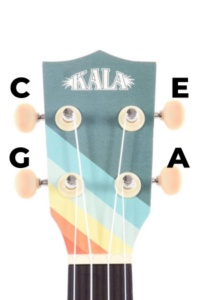 Ukulele Standard Tuning
Ukulele Standard Tuning
Probably the least similar aspect between a uke and a guitar is their respective tunings. Standard tuning on a guitar looks like this: E, A, D, G, B, and E in ascending order. On the ukulele, however, the bottom string is tuned higher than the next string up. The standard tuning for a ukulele is C, G, E, and A. So, strings one and four are tuned only a whole step apart.
This might seem confusing at first, especially if it feels like you only just wrapped your head around the guitar’s standard tuning. But remember: there are only four strings on this instrument. This means there are fewer notes you need to keep track of at one time!
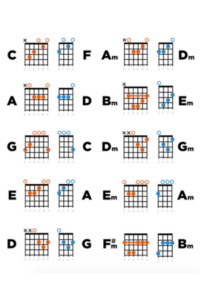 Chord Shapes
Chord Shapes
Despite the different tuning you find on a ukulele, there are a lot of similarities between it and a guitar. For instance, this instrument is fretted, so the notes are easily available to play. And, because of the intervals at which the top three strings on a ukulele are tuned, some of the same chord shapes you know on guitar will work on the uke! But there are some minor differences you’ll have to take into account because of the fourth string (G). Let’s take a look at a video by David Pots for a more in-depth explanation of the chord shapes you can use on the uke.
As David mentions, although some of the chord shapes are the same, the actual chords themselves will be different simply because the uke is tuned differently. For instance, the image above shows what we know as a “C” chord shape on guitar. But, on the ukulele, the notes we play by holding this shape spell an F chord. For more chord charts, check out Dave’s article explaining this further.
 Holding and Strumming a Ukulele
Holding and Strumming a Ukulele
The last tidbits of info you might need before you start your ukulele adventure are how to hold and strum this instrument! Unlike the guitar, the uke is probably too small to rest on your leg and play comfortably. Also, unless designed for it, the uke might not have a place to attach a strap.
So, we’ll have to use our arms to keep the instrument in position. With your left hand, hold the neck of the uke just like you would a guitar. You’ll be fretting notes the same way, after all. Lift the body of the ukulele up and cradle it inside your right elbow. You’ll use your right arm to keep the body of the instrument close to you while you strum.
When strumming a ukulele, it’s uncommon to use a pick or plectrum like we do with a guitar. So, the best way to strum a ukulele is with your fingers! Here’s a strumming tutorial video from Ukulele Magazine:
As Ukulenny explains, strumming on different places on the strings will produce a different tone. You’ll mostly use your thumb or index finger as the plectrum when strumming. Also, instead of moving your whole arm, you’ll want to move your hand at your wrist.
With that concludes our short summary of info you should know when transitioning from the guitar to the ukulele. Good luck on your journey, and happy Asian American and Pacific Islander Heritage Month!
For Song and Guitar Lessons, check out JamPlay.com! JamPlay has over 450 guitar courses from 120+ instructors, and online guitar lessons tailored to every skill level, music genre, and playing style. Click here to learn more.
Share this
Become a JamPlay member for unlimited access to 7000+ guitar lessons and 120+ artists and instructors. View membership plans ›
Related Posts
May 8, 2023
Bumblefoot Song Lesson Playlist
Bumblefoot is the stage name of Ron Thal, an American guitarist, songwriter, and producer. Born in 1969 in Brooklyn, New York, Bumblefoot is known for his technical and experimental approach to guitar playing guitar. He incorporates elements of rock, metal, funk, and other genres into his energetic brand of music.
Bumblefoot first gained recognition in the late 1990s as a guitarist for Guns N’ Roses, joining the band in 2006 and staying with them until 2014. He has also released several solo albums, including The Adventures of Bumblefoot and Abnormal, and has collaborated with many other notable musicians and bands throughout his career. In addition to his guitar playing, Bumblefoot is also a skilled producer and arranger; these are roles he’s taken when working on albums for other artists.
Fortunately for us at JamPlay, we were able to work directly with Bumblefoot to produce guitar lessons for some of his most notable songs. Let’s dive right into some Bumblefoot songs!
“Guitars Suck!” – Bumblefoot Song Lesson – JamPlay
Originally written in 1998 and titled, “Holland,” the song “Guitars Suck!” is said to have been meant for an instructional masterclass Ron was teaching. The title comes from a phone call Ron received during which a luthier friend of his exclaimed, “Dude, guitars suck!” This song is technically challenging to perform. Each beat is subdivided by 5, you’ll need to take your time when learning this odd-numbered rhythm. Additionally, this song will require you to pick and tap strings (including with a metal thimble you must wear on your picking hand pinky)!
In this lesson, Bumblefoot himself shows you how to play the whole song. For the breakdown with tab & notation, check out his full lesson on JamPlay!
“Guitars Still Suck!” – Song Lesson – JamPlay
“Guitars Still Suck!” is said to have been inspired by Ron’s friend, Guthrie Govan, who released a similar song. This tune was Bumblefoot’s “response” to his friend’s song. This is another technically challenging song to learn. Be prepared to practice your hybrid picking and tapping. It also wouldn’t hurt to have a fretless guitar attached to your six-string!
Follow along as Ron shows you how to play “Guitars Still Suck!” note-for-note. Get the full breakdown on JamPlay!
“Spaghetti” – Bumblefoot Song Lesson – JamPlay
Consider “Spaghetti” a respite from the first two lessons in this blog (in terms of technical difficulty). According to Ron, he needed a title for this track before releasing his Abnormal album. Because of its spaghetti western-sound-esque sound, he decided to publish it with its placeholder name, “Spaghetti!”
In this lesson, Ron teaches you how to play this track guitar track from start to finish. Get the tab & notation on JamPlay!
“Vomit” – Song Lesson – JamPlay
Lastly, here’s a Bumblefoot track that was a response to an overbearing record company: “Vomit.” According to Ron, he wrote this song because his record company told him he needed to write less “edgy” lyrics. Ron deemed that bodily functions were still fair game, and thus he created this interesting track. Learning how to play “Vomit” will come as a challenge, according to Ron, because it contains a decent amount of hybrid picking.
Luckily, Bumblefoot himself will walk you through each note until you can play this guitar masterpiece. Get the full lesson on JamPlay!
For more Song Lessons, check out JamPlay.com! JamPlay has over 450 guitar courses from 120+ instructors, and online guitar lessons tailored to every skill level, music genre, and playing style. Click here to learn more.
Share this
Become a JamPlay member for unlimited access to 7000+ guitar lessons and 120+ artists and instructors. View membership plans ›
Related Posts
April 27, 2023
International Jazz Day - Learn Some Jazz Guitar!
Keep your ears open this weekend – you may just hear some saints marching in! Why? Because April 30th is International Jazz Day, of course. As educators in music, this is one holiday we’d never miss. But what is Jazz Day, and how did it begin?
The United Nations Educational, Scientific and Cultural Organization (UNESCO) officially designated the day in 2011 to promote peace, dialogue among cultures, diversity, and respect for human rights and human dignity. The celebration of International Jazz Day involves various global events, including concerts, educational programs, workshops, and other community events that promote jazz music and its cultural significance.
Musicians from all over the world come together to participate in this event and share their unique perspectives on jazz. This year, American jazz pianist, Herbie Hancock will hosting a global concert series for International Jazz Day. The celebration will feature performances from jazz stars such as Dianne Reeves, Dee Dee Bridgewater, Christian McBride and many more.
How Will You Celebrate International Jazz Day?
Here at JamPlay, we’re celebrating all genres of guitar playing every day… including jazz! If you don’t know much about jazz, or have been curious to learn how to play it, today’s a great day to start. One thing to know about jazz guitar is that, as a guitar player in a jazz band, your job 90% of the time will be playing rhythm, or “comping.” So, let’s look at a few free jazz comping lessons you can use to get started on your jazz guitar journey!
Lear 4-Note Jazz Chords!
One of the hallmarks of jazz music is its ubiquitous use of the 7th in chords. If you’re not familiar with what 7th chords are, read in-depth about them by clicking here. Essentially, the fourth note we are adding to our chords is the seventh scale degree in relation to the root of the chords we are playing. Adding these notes to our chords adds dissonance. In jazz, this is not a frightening term! In fact dissonance is used to add texture and emotional complexity to jazz chord progressions.
But, do we always need all 4 notes? The answer is NO!
In this lesson, Marcelo Berestovoy explains how to play cleaner jazz chords by omitting unnecessary notes. This may seem counterintuitive to the previous lesson, but hear us out. Especially when playing in a band setting, playing a root, third, fifth, and seventh in each chord can sound… muddy. After all, you’ll be accompanying other harmonic instruments and soloists who are playing busy melodies.
This International Jazz Day, learn your first jazz chord progression!
Now that you’re more familiar with how jazz chords work, let’s learn a progression with Marcelo! In jazz and blues, it’s very common to play the ii-V-I (or, 2-5-1) progression. This means we’re playing the minor 2 chord, followed by the major 5, and major 1 chords. Marcelo even reveals an interesting alternative way to resolve this chord progression.
If you want to watch more jazz guitar lessons from Marcelo, check out his full course on JamPlay. Between practice breaks, don’t forget to wish your musician friends a Happy International Jazz Day this Sunday!
For more Jazz Guitar Lessons, check out JamPlay.com! JamPlay has over 450 guitar courses from 120+ instructors, and online guitar lessons tailored to every skill level, music genre, and playing style. Click here to learn more.
Share this
Become a JamPlay member for unlimited access to 7000+ guitar lessons and 120+ artists and instructors. View membership plans ›
Related Posts
April 26, 2023
Derek and The Dominos Song Lesson Playlist
Derek and The Dominos was a short-lived but highly influential band in the world of rock music. Led by guitar virtuoso Eric Clapton, the band formed in 1970 and released only one studio album, Layla and Other Assorted Love Songs. The album is considered a masterpiece of blues-rock, showcasing Clapton’s masterful guitar playing and the band’s tight musical interplay. Despite their short tenure, Derek and The Dominos left an indelible mark on the world of rock music, influencing generations of musicians to come.
Here at JamPlay, we work with the best guitar instructors around to create the most accurate and comprehensive song lessons for guitar. So, let’s learn how to play some of Derek and The Dominos’ top hits on guitar!
“Layla” – Derek and The Dominos Song Lesson – JamPlay
The album’s title track, “Layla,” has become one of the most recognizable and beloved rock songs of all time, with its soaring guitar riff and passionate vocals. Clapton wrote this song, along with most others from the record, about his infatuation with George Harrison’s wife, Patti Boyd. The recording sessions for Layla and Other Assorted Love Songs took place between August and October of 1970 at Criteria Studios in Miami, Florida, and were produced by Tom Dowd.
In this lesson with Lance Ruby, you’ll learn how to play all of the guitar parts for “Layla.” For the breakdown with tab & notation, check out Lance’s full lesson on JamPlay.
“Have You Ever Loved a Woman” – Song Lesson – JamPlay
Originally made famous in the 1960s by blues artist, Freddie King, “Have You Ever Loved a Woman” became a regular part of Eric Clapton’s repertoire. With the help of Duane Allman and producer Tom Dowd, Clapton’s version made its way onto Layla and Other Assorted Love Songs. Chock full of great blues riffs, “Have You Ever Loved a Woman” is a perfect tune to learn if you’re expanding your own blues guitar repertoire.
Luckily, educator Stuart Ziff is here to be your guide! Check out his full lesson on JamPlay for note-for-note breakdowns of this song featuring tab & notation.
For more Song Lessons, check out JamPlay.com! JamPlay has over 450 guitar courses from 120+ instructors, and online guitar lessons tailored to every skill level, music genre, and playing style. Click here to learn more.
Share this
Become a JamPlay member for unlimited access to 7000+ guitar lessons and 120+ artists and instructors. View membership plans ›
Related Posts
April 21, 2023
Taylor Swift & Her Greatest Musical Influences
Taylor Swift is undoubtedly one of the most successful and recognizable figures in contemporary music. With over 114 million records sold worldwide and numerous awards and accolades, including 12 Grammy Awards (and 46 nominations), she has achieved immense commercial success and critical acclaim. Her music has a wide appeal, spanning genres such as country, pop, and folk. Oh, and if you’re trying to get tickets to the latest Taylor Swift tour – good luck! Despite the astronomical prices of concert tickets these days, Taylor manages to practically sell out the biggest stadiums in the world.
In addition to her musical achievements, Taylor Swift has also been recognized for her activism and philanthropy, particularly in areas such as education, disaster relief, and LGBTQ+ rights.
So, it is safe to say that Taylor Swift has made a significant impact on the music industry and popular culture in general, and she remains a prominent figure in contemporary music.
But…
Who inspires Taylor Swift to create?
In this blog, we’ll be examining some of the artists that Taylor, herself, has credited as sources of her inspiration. The truth of the matter is, whether you’re a beginner or a musical legend, you’ve got a list of artists whose work lights a fire inside you. So, you might be surprised by some of Taylor’s! Let’s take a look at some songs you can learn from some of her favorite creators.
Note: These artists are in no particular order!
1. The Chicks (previously known as Dixie Chicks)
Taylor Swift hasn’t been shy about crediting The Chicks as one of her biggest musical and character influences. She states that The Chicks were exemplary in demonstrating how powerful feminism could be in a musical context. In an interview Taylor did with Billboard, she singled out the song, “Goodbye Earl” as one song that brought her an important revelation: that “female rage” can be a potent bonding factor between women.
In this lesson from D.J. Phillips, you’ll learn how to play “Goodbye Earl” note-for-note. For the breakdown with tab & notation, check out the full lesson on JamPlay!
2. Paul McCartney – A Taylor Swift Top 2
Paul McCartney is the No. 1 musical influence for countless guitarists, bassists, and songwriters alike. Well, Paul almost made the cut as Taylor Swift’s top pick; apparently he is second in line to cats as her all-time greatest influence. In more than one interview, Taylor has talked about her admiration for Paul’s music and lifelong musical career. Fortunately for her, Paul is also a Taylor Swift fan! The two even posed together for the cover of Rolling Stone Magazine in 2020.
In this lesson from Dennis Hodges, you’ll learn how to play one of Paul McCartney’s most famous songs: “Yesterday.” Although the song was published as a Beatles single in 1965 and credit was given to Lennon-McCartney, Paul was the primary songwriter on this timeless tune. For the breakdown with tab & notation, check out the full lesson on JamPlay!
3. Joni Mitchell – A Feminist Hero
Dubbed one of the greatest songwriters of all time, Joni Mitchell is a beloved icon of the folk music genre. Her lyrical honesty is enough to make you fall in love with her unorthodox compositions. As Taylor Swift aspired for lyrical greatness and a sense of feminist empowerment, Joni Mitchell was a source of inspiration. Taylor has not only covered Joni Mitchell’s music before, but she was even rumored to prospectively portray the 70s songwriter in a biopic (though some sources say this casting idea was scrapped).
In this lesson, Mark Brennan teaches you how to play one of Joni Mitchell’s hits, “Big Yellow Taxi” on guitar. For the note-for-note breakdown of this lesson, check out Mark’s full song lesson on JamPlay.
4. Fall Out Boy – An All-Time Taylor Swift Favorite
Early in the age of Taylor Swift, a band called Fall Out Boy emerged as an outlier in the emo/alternative rock scene. Though from very different musical worlds, Taylor has noted that Fall Out Boy (sometimes shortened to “FOB”) has had a massive influence on her lyric writing. In 2013, T-Swift and FOB joined forces to perform at the Victoria’s Secret Fashion Show.
Ready to learn an alternative classic? Follow along with Allen Van Wert as he demonstrates how to play “Dance, Dance” by Fall Out Boy. For the full lesson, check out Allen’s course on JamPlay.
5. John Mayer – The Ex Who Inspired Greatness
This last one may be a bit controversial for some obvious reasons. In the event you aren’t in-the-know, John Mayer is an ex-boyfriend of Taylor Swift. The relationship, which took place between 2009-2010, was very high profile and short-lived. However, things became contentious after both Taylor and John released their own diss tracks about each other and their perceived failures in the relationship. Nevertheless, before the all of the drama unfolded, John had an influence on Taylor’s writing, and she had an influence on his. In fact, they released a song together, “Half Of My Heart,” which aptly describes a couple with commitment issues.
In this lesson, Nick Greathouse shows you how to play John Mayer’s 2003 hit, “Daughters.” For the note-for-note breakdown of the song’s parts with tab, check out Nick’s full lesson on JamPlay.
For more Song Lessons, check out JamPlay.com! JamPlay has over 450 guitar courses from 120+ instructors, and online guitar lessons tailored to every skill level, music genre, and playing style. Click here to learn more.
Share this
Become a JamPlay member for unlimited access to 7000+ guitar lessons and 120+ artists and instructors. View membership plans ›
Related Posts
April 18, 2023

